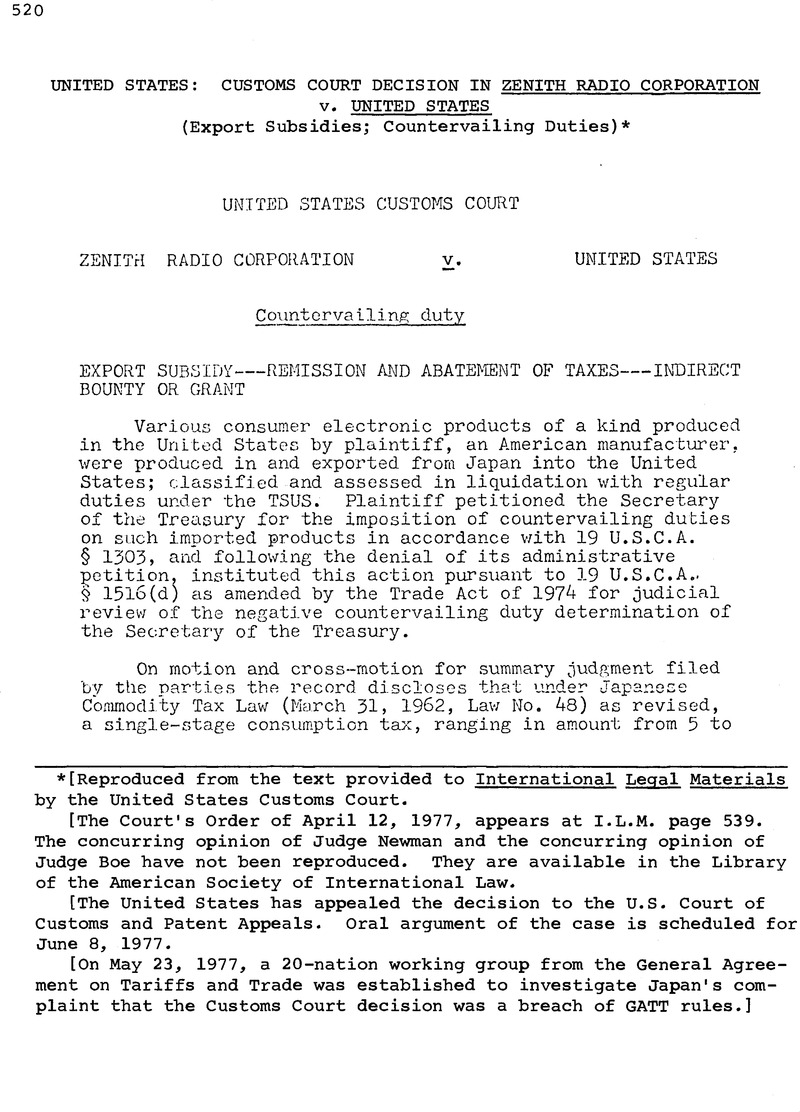No CrossRef data available.
Article contents
United States: Customs Court Decision in Zenith Radio Corporation v. United States (Export Subsidies; Countervailing Duties)*
Published online by Cambridge University Press: 20 March 2017
Abstract

- Type
- Judicial and Similar Proceedings
- Information
- Copyright
- Copyright © American Society of International Law 1977
Footnotes
[Reproduced from the text provided to International Legal Materials by the United States Customs Court.[The Court's Order of April 12, 1977, appears at I.L.M. page 539. The concurring opinion of Judge Newman and the concurring opinion of Judge Boe have not been reproduced. They are available in the Library of the American Society of International Law.[The United States has appealed the decision to the U.S. Court of Customs and Patent Appeals. Oral argument of the case is scheduled for June 8, 1977.[On May 23, 1977, a 20-nation working group from the General Agreement on Tariffs and Trade was established to investigate Japan's complaint that the Customs Court decision was a breach of GATT rules.]
References
1 / The three-judge panel in this case was designated by thechief judge upon application of defendant pursuant tosection 108 of the Customs Courts Act of 1970 (28 U.S.C.A.255) and rule 4.13 of this court.
2 / Television receivers, radio receivers, radio-phonographcombinations, radio-television-phonograph combinations,radio-tape recorder combinations, record players andphonographs complete with amplifiers and speakers, taperecorders, tape players, and color televinioci picturetubes.
3 / Tax exempt status is also accorded to certain othercategories of goods, not here pertinent, which aresold domestically to or for schools, other educationalinstitutions and educational use, academic research organs and academic research use, social welfare institutions and persons engaged in social welfare activities, the National Museum, and other persons specified by government ordinance. (Defendant's cross-motion for summary judgment p.2.)
4 / But even this, exemption was conditional, and, notallowed where the requisite certificate was not produced. See T.D. 16641 (1895).
5 / This provision expressly prohibits contracting partiesfrom levying countervailing duties against each other'sproducts to offset export bounties aiding their exportation where the bounties are in the form of tax remissions or tax exemptions; and the Government maintains that such contractual obligation is binding on the United States.
* [Reproduced from the text provided to International Legal Materials by the United States International Trade Commission.[The actions by the United States President with respect to the report of the International Trade Commission appear at I.L.M. page 588. The Orderly Marketing Agreement to limit the number of Japanese color television receivers, signed on May 20, 1977, appears at I.L.M. page 631 Under the United States Trade Act of 1974, the Congress has 90 working days in which to consider resolutions of disapproval of the Orderly Marketing Agreement as the appropriate remedy. The Trade Act of 1974 appears at 14 I.L.M. 181 (1975).]




